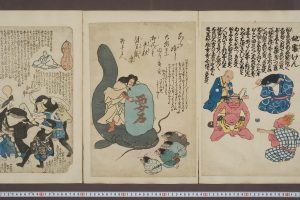Earthquakes & volcanos in Japan
1.6 Past earthquakes in Japan
*The contents may be subject to change without prior notice.
K. Z. Nanjo and K. Oike
NaDiR, Global Center for Asian and Regional Research, University of Shizuoka
To supplement the information given in the Section 1.5, this section lists major earthquakes that hit Japan in the past. According to the Chronological Scientific Tables (Rika Nenpyo in Japanese), as many as 500 destructive earthquakes have occurred in and around Japan. A knowledge of some of these earthquakes will help raise awareness of the importance of disaster preparedness for citizens living in an earthquake-prone country.
- Ingyo earthquake: August 23, 416. The Chronicles of Japan (Nihon Shoki in Japanese) (1) refers to it simply as an “earthquake” and has no mention about the damage it caused. This is the first earthquake recorded in Japanese history, but questions remain about its authenticity.
- Hakuho (Tenmu) earthquake: November 29, 684. This great earthquake is considered to have occurred along the Nankai Trough (Chapter 3, TBA). Records describe that the tsunami induced by the earthquake sunk many ships in Tosa region (today’s Kochi Prefecture). This is the Japan’s oldest record of a tsunami.
- Hoei earthquake: October 28, 1707. This is considered to be one of the largest earthquakes in Japan. Its source region covered a vast area along the Nankai Trough from the sea off the coast of Shikoku to the Enshu Sea (Wikipedia) (2) (Fig. 3-3, TBA). The damage was especially serious in the Tokaido district, the coast along Ise Bay, and the Kii Peninsula. The earthquake was followed by a major eruption of Mt. Fuji on December 16, 1707 (Hoei eruption).
- Ansei Tokai and Nankai earthquakes: December 23 and 24, 1854. Both earthquakes recorded M8.4. The Tokai earthquake that occurred on December 23 destroyed almost half of the plate boundaries along the Nankai Trough (so-called “hanware” or half rupture). Its source region was the eastern area off the coast of the Kii Peninsula. Thirty-two hours later, another huge Nankai earthquake struck, with its source region located along the boundary lying west off the coast of the Kii Peninsula (Fig. 3-3, NBA). Both earthquakes induced tsunami that caused extensive damage.
- Nobi earthquake: October 28, 1891. This M8.0 earthquake was caused by a slip along the Neodani fault zone with the epicenter in the western part of Gifu Prefecture. It is one of the largest inland earthquakes in Japanese history. In some places, vertical slip of 6 meters and horizontal slip of 2 meters were observed. The shaking was felt all over Japan south of Sendai City.
- Kanto earthquake: September 1, 1923. This earthquake recorded M7.9, and caused disaster called the Great Kanto Earthquake (Fig. 1-5). Fires broke out following the earthquake, causing extensive damage. To remember this disastrous event, Japan designated September 1 as National Disaster Prevention Day. Around this date, emergency drills are conducted every year throughout the country.
- Showa Tonankai and Nankai earthquakes: December 7, 1944 and December 21, 1946. A M7.9 Tonankai earthquake occurred in 1944 with its source region covering the plate boundary lying east off the coast of the Kii Peninsula, followed by a M8.0 Nankai earthquake in 1946 with its source region covering the plate boundary lying west off the coast of the Kii Peninsula (Fig. 3-3, TBA). The 1946 earthquake occurred at a place that did not rupture during the 1944 earthquake. This pair of earthquakes is considered to be the latest Nankai Trough earthquake, and both of them induced tsunamis that caused extensive damage.
- Kobe earthquake: January 17, 1995. This M7.3 earthquake caused disaster called the Great Hanshin and Awaji Earthquake (Fig. 1-5), and was an inland earthquake due to a slip along the active fault zone called the Rokko-Awaji fault zone. The maximum seismic intensity of 7 was recorded in Kobe City. The earthquake caused the collapse of highways and railway tracks including Shinkansen tracks.
- Tohoku earthquake: March 11, 2011. This M9.0 earthquake is known to cause disaster called the Great East Japan Earthquake. Its source region was located on the plate boundary extending from the area off the coast of Sanriku (Wikipedia) (3) to the area off the coast of Ibaraki Prefecture. This massive earthquake was preceded by several foreshocks, including a M7.3 earthquake on March 9. The source region and its vicinity were hit by as many as six aftershocks and induced earthquakes of M7.0 or larger. Most damage was caused by tsunami (Fig. 1-4, Fig. 1-5, and Fig. 3-8, TBA).
- Kumamoto earthquakes: April 14 and 16, 2016. A M6.5 earthquake occurred in the Hinagu fault zone in Kumamoto on April 14, followed by a M7.3 earthquake in the adjacent Futagawa fault zone on April 16. During these earthquakes, the seismic intensity of 7 was recorded twice. This was the first time since the current seismic intensity scale was established by the JMA that the seismic intensity of 7 was observed twice in an earthquake sequence. In the wake of these earthquakes, public attention was drawn to the earthquake-resistant temporary housing and home evacuation (Fig. 5-2, TBA).

Sources and references
- National Treasure, Nihon Shoki (An ancient history of Japan), Nara National Museum
- Enshu Sea (28 October 2024). In Wikipedia: The Free Encyclopedia
- Sanriku (28 March 2025). In Wikipedia: The Free Encyclopedia
- Image courtesy of the University of Tokyo General Library – Araureshi Daian’nichi-ni Yurinaosu 「あら嬉し大安日にゆり直す」